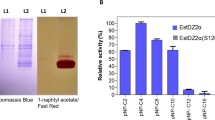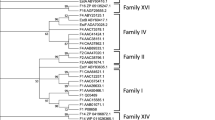Abstract
The enzymatic regioselective hydrolysis of (a) acetylated mono- to tetrasaccharides of different nature, (b) of acetylated aryl glycosides and (c) of different acetylated nucleosides was studied enlarging the portfolio of substrates that can be employed by the thermophilic esterase EST2 from Alicyclobacillus acidocaldarius. The reactions were optimised to the extent that the amount of enzyme needed was lowered of two orders of magnitude with respect to the previously reported reactions, namely from 4000 to 40 U of enzyme per reaction. New additional solvents were screened and dramatic changes in regioselectivity were observed depending on the amount and type of solvent used. For example, in the presence of 10 % DMF, only two α-d-glucose products 6-OH and 4,6-OH (in a 76:24 ratio) were detected, whereas with 25 % DMF, at least four products of similar amount were observed. This versatility adds specific value to the biocatalyst making possible the design of biocatalytic reactions with different hydrophobic ester substrates. As an additional remarkable example, EST2 catalysed with a good yield and high regioselectivity the hydrolysis of p-nitrophenyl β-d-xylopyranoside triacetate producing only the monoacetylated derivative with acetyl group in 3-O-position, in 2 min. The results with nucleosides as substrates are particularly interesting. The peracetates of 3′,5′-di-O-acetylthymidine are converted almost quantitatively (95 %) to the monoacetylated derivative possessing free secondary OH; this regioselectivity is complementary to hydrolysis/alcoholysis reactions catalysed by CAL-B lipase or to other microbial hydrolytic biocatalysts, generally giving products with free primary OH groups. A docking analysis was undertaken with all analysed substrates suggesting a structural interpretation of the results. In most of cases, the best pose of the selected substrate was in line with the observed regioselectivity.









Similar content being viewed by others

References
Aggarwal N, Arya A, Mathur D, Singh S, Tyagi A, Kumar R, Rana N, Singh R, Prasad AK (2014) Effect of acyl chain length on selective biocatalytic deacylation on O-aryl glycosides and separation of anomers. Bioorg Chem 53:83–91
Barbayianni E, Kokotos G (2012) Biocatalyzed Regio- and Chemoselective Ester Cleavage: synthesis of Bioactive Molecules. Chem Cat Chem 4:592–608
Burton SG, Cowan DA, Woodley JM (2002) The search for the ideal biocatalyst. Nat Biotechnol 20:37–45
Erbeldinger M, Mesiano AJ, Russell AJ (2000) Enzymatic catalysis of formation of Z-aspartame in ionic liquid - An alternative to enzymatic catalysis in organic solvents. Biotechnol Prog 16(6):1129–1131
Ferrero M, Gotor V (2000) Biocatalytic selective modifications of conventional nucleosides, carbocyclic nucleosides, and C-nucleosides. Chem Rev 100:4319–4347
Ichikawa E, Kato K (2001) Sugar-modified nucleosides in past 10 years, a review. Curr Med Chem 8:385–423
Itoh T, Akasaki E, Kudo K, Shirakami S (2001) Lipase-catalyzed enantioselective acylation in the ionic liquid solvent system: reaction of enzyme anchored to the solvent. Chem Lett 262–263
Kim KW, Song B, Choi MY, Kim MJ (2001) Biocatalysis in ionic liquids: markedly anhanced enantioselectivity of lipase. Org Lett 3:1507–1509
Lau RM, Rantwijk FV, Seddon KR, Sheldon RA (2000) Lipase-catalyzed reactions in ionic liquids. Org Lett 2:4189–4191
Li N, Smith TJ, Zong MH (2010) Biocatalytic transformation of nucleoside derivatives. Biotechnol Adv 28:348–366
Lozano P, Diego TD, Carrié D, Vaultier M, Iborra JL (2001) Over-stabilization of Candida antarctica lipase B by ionic liquids in ester synthesis. Biotechnol Lett 23:1529–1533
Manco G, Adinolfi E, Pisani FM, Ottolina G, Carrea G, Rossi M (1998) Overexpression and properties of a new thermophilic and thermostable esterase from Bacillus acidocaldarius with sequence similarity to hormone- sensitive lipase subfamily. Biochem J 332:203–212
Manco G, Carrea G, Giosuè E, Ottolina G, Adamo G, Rossi M (2002) Modification of the enantioselectivity of two homologous thermophilic carboxylesterases from Alicyclobacillus acidocaldarius and Archaeoglobus fulgidus by random mutagenesis and screening. Extremophiles 6:325–331
Mandrich L, Merone L, Pezzullo M, Cipolla L, Nicotra F, Rossi M, Manco G (2005) Role of the N terminus in enzyme activity, stability and specificity in thermophilic esterases belonging to the HSL family. J Mol Biol 345:501–512
Mandrich L, Merone L, Manco G (2009) Structural and kinetic overview of the carboxylesterase EST2 from alicyclobacillus acidocaldarius: a comparison with the other members of the HSL family. Protein Peptide Lett 16:1189–1200
Mandrich L, De Santi C, de Pascale D, Manco G (2012) Effect of low organic solvents concentration on the stability and catalytic activity of HSL-like carboxylesterases: analysis from psychrophiles to (hyper)thermophiles. J Mol Catal B: Enzymatic 82:46–52
Nara SJ, Harjani JR, Salunkhe MM (2002) Lipase-catalysed transesterification in ionic liquids and organic solvents: a comparative study. Tetrahedron Lett 43:2979–2982
Nara SJ, Mohile SS, Harjani JR, Naik PU, Salunkhe MM (2004) Influence of ionic liquids on the rates and regioselectivity of lipase-mediated biotransformations on 3,4,6-tri-O-acetyl-d-glucal. J Mol Catal B: Enzymatic 28:39–43
Panero J, Trelles J, Rodano V, Montserrat JM, Iglesias LE, Lewkowicz ES, Iribarren AM (2006) Microbial hydrolysis of acetylated nucleosides. Biotechnol Lett 28:1077–1081
Park S, Kazlauskas RJ (2001) Improved preparation and use of room- temperature ionic liquids in lipase-catalyzed enantio- and regioselective acylations. J Org Chem 66(25):8395–8401
Sandoval M, Civera C, Berenguer J, García-Blanco F, Hernaiz MJ (2013) Optimised N-acetyl-d-lactosamine synthesis using Thermus thermophilus b-galactosidase in bio-solvents. Tetrahedron 69:1148–1152
Schöfer SH, Kaftzik N, Wasserscheid P, Kragl U (2001) Enzyme catalysis in ionic liquids: Lipase catalysed kinetic resolution of 1-phenylethanol with improved enantioselectivity. Chem Commun 425–426
Schüttelkopf AW, van Aalten DMF (2004) PRODRG: a tool for high-throughput crystallography of protein-ligand complexes. Acta Crystallogr D 60:355–1363
Waidmann H, Heuser A (1994) Acetylesterase from orange peel as biocatalyst for the chemo- and regioselective deprotection of carbohydrates. Bioorgan Med Chem 2(5):477–482
Wheelock CE, Phillips BM, Anderson BS, Miller JL, Miller MJ, Hammock BD (2008) Applications of carboxylesterase activity in environmental monitoring and toxicity identification evaluations (TIEs). Rev Environ Contam Toxicol 195:117–178
Whistle RL, Tu CCJ (1952) Isolation and properties of a series of crystalline oligosaccharides from xylan. Amer chem Soc 74:3609–3612
Zinni MA, Rodrìguez SD, Pontiggia RM, Montserrat JM, Iglesias LE, Iribarren AM (2004) Enzymatic alcoholysis of 3′,5′-di-O-acetyl-2′-deoxynucleosides. J Mol Catal B: Enzymatic 29:129–132
Author information
Authors and Affiliations
Corresponding authors
Additional information
Communicated by F. Robb.
Rights and permissions
About this article
Cite this article
Pennacchio, A., Mandrich, L., Manco, G. et al. Enlarging the substrate portfolio of the thermophilic esterase EST2 from Alicyclobacillus acidocaldarius . Extremophiles 19, 1001–1011 (2015). https://doi.org/10.1007/s00792-015-0774-x
Received:
Accepted:
Published:
Issue Date:
DOI: https://doi.org/10.1007/s00792-015-0774-x



